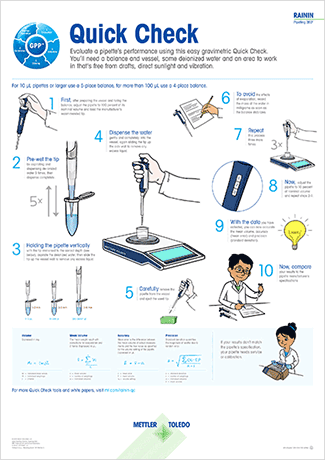 |
Pipetting is a frequent and important activity in many life science applications. The purpose of pipetting is to reliably deliver accurate volumes. In most cases, pipetting is the first step in an experimental workflow and as such has a significant impact on the final experimental result.
To ensure accurate pipetting results, a user should understand the principles of testing a pipette for accuracy, and pipettes should be tested routinely between calibration intervals.
Regardless of the pipette brand, physical damage caused by dropping instruments, or sharing pipettes between users, can contribute to inconsistent results. Age and wear and tear of pipettes can also affect pipetting accuracy.
The consequences of erratic pipetting are not immediately visible, unfortunately. Only when the experimental results seem inconsistent, might one suspect the pipette may have been at fault. As a result, users may be required to repeat partial or even entire experiments, wasting time, reagents, samples and money.
Routine testing of pipettes at regular intervals or even before each experiment is a recommended practice that can help confirm that the pipette delivers accurate results. It also proves that if the test is done by the same person, the pipetting technique is correct and helps to evaluate and improve the overall pipetting technique.
A pipette test can be defined as the verification process performed by a user, which could happen as many times as needed by the user in a time period. Pipette testing can be scheduled on a regular basis and done in between professional service. It provides additional security between calibrations and is crucial when protocols involve steps or reagents that require high accuracy.
A pipette accuracy-test confirms that a pipette is still fit for its intended use and drastically reduces risks of out of tolerance (OOT) results. Routine testing, also called a pipette test or performance test, is not the same as calibration and must be considered an important pillar in pipette performance activities.
Various protocols exist for pipette accuracy testing. This guide focuses on the gravimetric measurement procedure, which determines the mass of water delivered by a pipette and hence the associated volume, and presents an innovative routine testing device.
SmartCheck is the first device in the industry that is specifically designed to perform pipette accuracy testing. SmartCheck has a proprietary technology consisting of a weighing cell that automatically recognizes the test volume. Based on four replicates, the device provides a quick, yet reliable confirmation showing if the pipette and its user deliver accurate volumes.
Find out more by reading the "Pipette Routine Testing" guide.







